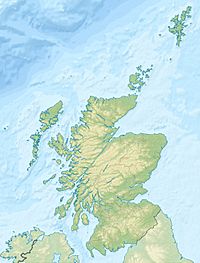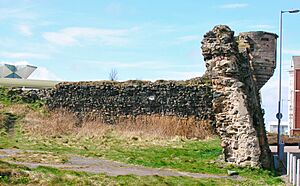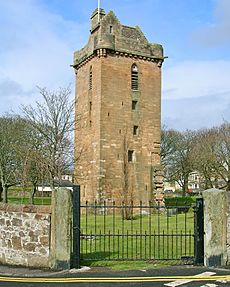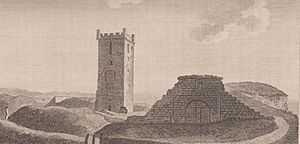Montgomerieston facts for kids
Montgomerieston, also called Montgomeryston or Ayr Fort, was a small town area in Ayr, South Ayrshire, Scotland. It was only about 16 acres (6.5 hectares) big. This area was inside the walls of the old Ayr Citadel, which was also known as Cromwell's Fort. Montgomerieston was named after the Montgomerie family, who were the Earls of Eglinton.
Contents
History of Montgomerieston
Cromwell's Fort in Ayr
During the time of Oliver Cromwell, five large forts called citadels were built in Scotland. These forts helped Cromwell control the Scots. Ayr's citadel was the biggest, built between 1652 and 1653.
A Dutch architect named Hans Ewald Tessin designed the Ayr Citadel. It had a six-sided shape with six strong towers called bastions. Building it was hard because the sandy ground kept collapsing. The fort also had a moat filled with fresh water around it. This moat was about 90 feet wide in some places.
After 1660, parts of the citadel were taken apart. This was done to stop anyone from using it against King Charles II. The moat was finally filled in around 1800. Wells were dug inside the fort to give soldiers their own water supply. The parts of the fort facing the sea were kept. They could be used as a battery if needed.
The Earls of Eglinton and the New Town
After King Charles II returned to power, these citadels became special towns called burghs. The 7th Earl of Eglinton, Hugh, had lost a lot because he supported King Charles I. To make up for this, the Ayr Citadel was given to him. He named it 'Montgomerieston' after his family.
Another reason for this gift was that the Montgomerie family's own castle, Ardrossan Castle, had been taken apart. Its stones were used to help build the Ayr Citadel. The stones in the citadel look like those from Ardrossan Castle. The fort was built so fast that Cromwell supposedly asked, Has it been built of Gold?
The town leaders of Ayr did not like the creation of 'Montgomeriestoun' in 1663. Later, the town was given to the Kennedy family to pay off a debt. One good thing about the citadel was that it protected the church and the town from sand blown in from the sea.
Later Owners of Montgomerieston
In 1687, John Muir, who was the Provost (a type of mayor) of Ayr, bought Montgomerieston. He bought it from Lord Alexander Montgomerie.
In 1727, Susanna Montgomery, Countess of Eglinton, bought the area. She was from the Kennedy family. In 1747, people complained that the Countess had blocked access across the old moat. This stopped people from walking where they wanted.
In 1755, Countess Susanna sold the area to Sir Thomas Kennedy. He later became the 9th Earl of Cassillis. The area stayed mostly the same until 1854. That's when a man named John Miller bought it.
Baron Miller's Changes
In the 1850s, John Miller, a collector and gunsmith, returned to Ayrshire. He had become very rich in Calcutta. Miller bought Montgomerieston and built a home in a Gothic style. He used the tower of St John's church as the main part of his house.
He also added an extension to a small tower on one of the bastions. This extension is now known as 'Miller's Folly'. John Miller was a bit unusual and called himself 'Baron Miller' of Montgomerieston. He sold off most of the land for houses. Miller died in 1910.
In 1914, the 3rd Marquess of Bute bought what was left of the area. The 4th Marquess restored St John's Tower. In 1949, the 5th Marquess gave it to the town of Ayr.
St John the Baptist's Church
This church was first mentioned in 1233. It was a medieval church named after Saint John the Baptist. Cromwell's soldiers used the church as a lookout tower, an armory, and a chapel. The churchgoers had to leave and built a new church, the Auld Kirk of Ayr. Cromwell even helped them with some money.
The 'Citadel' church was used by the public again from 1687 to 1689. After that, it was no longer used for worship. Most of it was torn down. The tower itself was saved because it was a useful landmark for sailors. It also served as a lookout for ships.
People continued to be buried there, according to comments from 1789. When the Countess of Eglinton bought the area, the town leaders were worried about the tower. It was repaired and a flat roof was added. The old Ayr castle was also near the church, inside the citadel walls.
John Miller built his 'Fort Castle' home around the tower. In 1913-1914, the tower was restored. It was made to look like it did in old drawings, thanks to the Marquesses of Bute.
There's a story that a secret tunnel ran from St John's tower to Greenan Castle. In the 1950s, people reported finding its entrance. They even told stories of skeletons hanging in chains inside.
Montgomerieston's Businesses
Early Business Attempts
The Earls of Eglinton tried to make Montgomerieston a successful business area. They wanted it to compete with the main town of Ayr. In 1662, the Earl of Eglinton was given special rights. He could use the labor of unemployed people from nearby areas.
These people were brought to Montgomerieston, where the Earl had a wool factory. Local landowners had to pay for these workers' support. The Earl only had to provide food and clothes. These rights lasted for several years.
Despite the low costs, this wool business did not do well. It disappeared from records after a short time. The buildings were then turned into a brewery. Records show that in 1664-1665, the town of Irvine paid for two "poor boys" housed at the "manufactory of Ayre alias Montgomeriestoun." The workers' behavior was very poor. In 1665, the Archbishop of Glasgow urged the Earl to control them.
Montgomerieston Brewery
Susanna Montgomery, Countess of Eglinton, started a brewery here when she owned the land. Records from 1734 show that whisky was also made here. Cinnamon and herbs were used to make different drinks.
In 1754, tenants rented the brewery buildings. In 1787, the Ayr town leaders went to court. They wanted the brewery to pay certain taxes. However, the court decided that the Earl had the right to these payments. This confirmed that Montgomerieston was an independent area. The brewery and a kiln brought in £50 sterling rent each year.
Montgomerieston as a Home Area
In the 1850s, Baron Miller planned Montgomerieston as a place for homes. His plan showed a square layout with a round area in the middle. However, this exact plan was not followed.
Today, many street names in the area remember its history. For example, Eglinton Terrace and Montgomerie Terrace are named after the first barons. Cassillis Street and Ailsa Place are named after the Kennedy barons. Cromwell Road remembers Oliver Cromwell.







